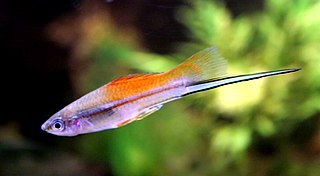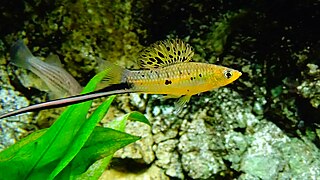
The southern platyfish, common platy, or moonfish is a species of freshwater fish in family Poeciliidae of order Cyprinodontiformes. A live-bearer, it is closely related to the green swordtail and can interbreed with it. It is native to an area of North and Central America stretching from Veracruz, Mexico, to northern Belize.

Xiphophorus is a genus of euryhaline and freshwater fishes in the family Poeciliidae of order Cyprinodontiformes, native to Mexico and northern Central America. The many Xiphophorus species are all known as platyfish and swordtails. Platyfish formerly were classified in another genus, Platypoecilia, which is now obsolete. The type species is X. hellerii, the green swordtail. Like most other new world Poeciliids, platies and swordtails are live-bearers that use internal fertilization and give birth to live young instead of laying eggs like the bulk of the world's fishes. The name Xiphophorus derives from the Greek words ξίφος (dagger) and φόρος (bearer), referring to the gonopodium on the males. All are relatively small fishes, which reach a maximum length of 3.5–16 cm (1.4–6.3 in) depending on the exact species involved.

The variable platyfish, also known as variatus platy or variegated platy, is a species of freshwater fish in family Poecilidae of order Cyprinodontiformes. A livebearer, it is native to southern Tamaulipas and northern Veracruz states in northeastern Mexico. It is a popular fish in the aquarium trade due to its prolific breeding, as are hybrids with other members of its genus, most notably the southern platyfish.

Cerro El Potosí is the highest mountain in the Sierra Madre Oriental mountain range of northeast Mexico. It is located in the state of Nuevo León, about 80 km (50 mi) south of Monterrey.

The Pánuco River, also known as the Río de Canoas, is a river in Mexico fed by several tributaries including the Moctezuma River and emptying into the Gulf of Mexico. The river is approximately 510 kilometres (320 mi) long and passes through or borders the states of Mexico, Hidalgo, Querétaro, San Luis Potosí, Tamaulipas, and Veracruz. According to the Atlas of Mexico, it is the fourth-largest river in Mexico by volume of runoff, and forms the sixth-largest river basin in Mexico by area.
Wendell Lee Minckley was a college professor and leading expert on fish. He spent most of his career at Arizona State University. In 1963, he with Robert Rush Miller discovered and named the northern platyfish in honor of Dr. Myron Gordon. Dr. Minckley, in turn, had five species named in his honor. Dr. Minckley died on June 22, 2001, in Desert Samaritan Hospital in Mesa, Arizona, from complications associated with treatment for cancer.
Potosi pupfish is a species of fish in the family Cyprinodontidae. It is endemic to Mexico, but is now extinct in the wild, only surviving in captivity.
Girardinichthys is a genus of splitfins that are endemic to Mexico. These highly threatened fish are native to the upper Lerma and Balsas basins, as well as water systems in the Valley of Mexico. Through man-made channels G. viviparus has been able to spread to the upper Pánuco River basin. These small fish reach up to 6.5 cm (2.6 in) in length. The name of this genus honours the American herpetologist and ichthyologist Charles Girard (1822-1895).
The yellow swordtail is a species of freshwater fish in the family Poeciliidae. It is endemic to the upper Coatzacoalcos River basin in southern Mexico. It is typically found in brooks and streams with slow current; it is less frequent in areas with strong current. The yellow swordtail is considered a threatened species by Mexican authorities. It reaches up to 5.1 cm (2.0 in) in standard length.
The northern platyfish is a small, endangered species of fish in the family Poeciliidae. It is endemic to the vicinity of Cuatro Ciénegas in the Mexican state of Coahuila. It is restricted to hot-spring heated ditches and marshes of the Laguna Santa Tecla. Its native water is shallow and vegetation-choked, with very stable temperatures that generally are around 27–30 °C (81–86 °F), although captive studies show the species also can live in slightly colder water.

The marbled swordtail is a species of freshwater fish in the family Poeciliidae. It was endemic to the Rio Salado system in Coahuila, northeastern Mexico. It was restricted to springs, connected creeks and pools in waters with a pH slightly above neutral and temperatures of 16–26 °C (61–79 °F), with captive studies indicating that the optimum temperature is around 24 °C (75 °F).
The Chiapas swordtail or upland swordtail is a species of livebearing freshwater fish of family Poeciliidae, and genus Xiphophorus. It is, therefore, in the same genus as the common platy and the swordtail. The Chiapas swordtail was discovered and first described by Donn E. Rosen in 1960, along with four other species of Xiphophorus.

The green swordtail is a species of freshwater/brackish fish in family Poeciliidae of order Cyprinodontiformes. A live-bearer, it is closely related to the southern platyfish or 'platy' and can crossbreed with it. It is native to an area of North and Central America stretching from Veracruz, Mexico, to northwestern Honduras.

Xiphophorus montezumae, the Montezuma swordtail, is a livebearing freshwater fish of the order Cyprinodontiformes, family Poeciliidae, and genus Xiphophorus. It is in the same genus as the common platy and the swordtail. Xiphophorus means 'sword-bearer' in Greek.

Xiphophorus nezahualcoyotl, the mountain swordtail, is a live bearing fish in the family Poeciliidae. It is endemic to the northwestern Pánuco River basin in Mexico. The specific name of this fish refers to the poet, philosopher and emperor of Texcoco, Nezahualcoyotl (1402-1472).
Xiphophorus birchmanni, commonly known as the sheephead swordtail, is a live bearing fish in the family Poeciliidae.

Xiphophorus continens, also known as El Quince swordtail or short-sword platyfish, is a live-bearing freshwater fish in the family Poeciliidae. It is endemic to the Pánuco River basin in east-central Mexico. Its name comes from the Greek conto, meaning short, and Latin ensis, meaning "sword". due to the species' sword size in males.
Xiphophorus malinche, also known as highland swordtail, is a live bearing fish in the family Poeciliidae. It is endemic to the Pánuco River basin in east-central Mexico. This species is named after La Malinche, an Indian slave who played a role in the Spanish conquest as the interpreter, secretary, and mistress of Hernando Cortes.

Xiphophorus pygmaeus, the pygmy swordtail, is a poeciliid fish from northeastern Mexico. It is the smallest of the swordtails. The male's sword is barely visible and the species is often called the swordless swordtail. It is sometimes kept in home aquaria, but is a rather delicate species.

Xiphophorus milleri, the Catemaco platyfish, is a poeciliid fish endemic to Mexico's Lake Catemaco and its tributaries. As it has traits of both swordtails and platies, its discovery confirmed that these two groups should be consolidated into a single genus, Xiphophorus.













